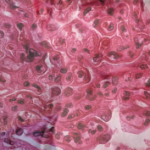Lupus Nephritis Treatment
Lupus nephritis traditionally has had poor response rates. “In most trials, mycophenolate is the typical comparator arm, with only 20% of patients reaching even the incomplete renal response of 500 mg/gm at 12 months,” Dr. Petri said.
Dr. Petri likes to think of lupus nephritis treatment as “mycophenolate plus” with use of mycophenolate with three other choices. “Whether you decide to pick belimumab, voclosporin or obinutuzumab, they all double the response rate vs. mycophenolate alone,” she said.
Voclosporin reduces proteinuria rapidly, even within the first month, and is often Dr. Petri’s first choice for someone with high degree of proteinuria. Belimumab may be favored for those with extra-renal lupus manifestations, frequent infections or malignancy history. Finally, she highlighted obinutuzumab as a good option for patients who are non-adherent to treatment, given it is administered intravenously.
In some high-risk patients with inadequate response, Dr. Petri has also implemented a regimen she calls “mycophenolate plus plus,” incorporating the use of mycophenolate, belimumab and a calcineurin inhibitor.
Dr. Petri said the urine proteome will ultimately allow more rapid and frequent measurement of both lupus nephritis activity and renal damage, rather than just relying on end-of-treatment kidney biopsies.
“There are three major families of urine proteins that highly correlate with the NIH activity index: IL-16, CD-163 and PR-3,” Dr. Petri explained, highlighting results based on the work of Andrea Fava, MD, from the Johns Hopkins University School of Medicine. In the future, she thinks there will be a urine dipstick for nephritis testing multiple urine proteins, offering a window at every visit to assess if lupus activity is being adequately treated and GFR loss is being prevented.
“Urine biomarkers are better at predicting 1-year response than proteinuria as measured by the UPCR,” said Dr. Petri.
She also highlighted cellular therapy and the use of CD19-targeted chimeric antigen receptor (CAR) T cells in patients with refractory SLE.8 “Deep B cell depletion really matters,” Dr. Petri explained. “The immune system resets in a naive way, and these patients preserve their vaccine response.” Some recent data of CAR T trials in lupus nephritis show ongoing proteinuria after treatment. Dr. Petri believes an end-of-treatment renal biopsy in CAR T treated patients is critical because this is a more accurate determination of renal cure than proteinuria, which may reflect chronic scarring in some patients.
“I don’t know where cellular therapy will end up in lupus nephritis,” she said. “I don’t know how anyone will know without end-of-treatment biopsies.”



